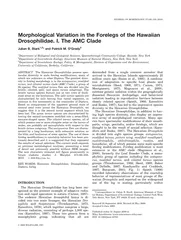

CorrespondencetoJulianBStarkAmericanMuseumofNaturalHistoryDepartmentofInvertebrateZoologyCentralParkWest79thStreetNewYorkNY10024EmailstarkamnhorgReceived25September2008Revised22May2009 ID: 91074
Download Pdf The PPT/PDF document "Morphological Variation in the Forelegs ..." is the property of its rightful owner. Permission is granted to download and print the materials on this web site for personal, non-commercial use only, and to display it on your personal computer provided you do not modify the materials and that you retain all copyright notices contained in the materials. By downloading content from our website, you accept the terms of this agreement.
MorphologicalVariationintheForelegsoftheHawaiianDrosophilidae.I.TheAMCCladeJulianB.Stark*andPatrickM.OGradyDepartmentofBiologicalandGeologicalSciences,QueensboroughCommunityCollege,Bayside,NewYorkDepartmentofInvertebrateZoology,AmericanMuseumofNaturalHistory,NewYork,NewYorkDepartmentofInvertebrateZoology,Policy,&Management,DivisionofOrganismsandtheEnvironment,UniversityofCalifornia,Berkeley,CaliforniaTheHawaiianDrosophilidaepossessspec- *Correspondenceto:JulianB.Stark,AmericanMuseumofNatu-ralHistory,DepartmentofInvertebrateZoology,CentralParkWest,79thStreet,NewYork,NY10024.E-mail:stark@amnh.orgReceived25September2008;Revised22May2009;Accepted6June2009Publishedonline31August2009inWileyInterScience(www.interscience.wiley.com)DOI:10.1002/jmor.10783JOURNALOFMORPHOLOGY271:86 103(2010)2009WILEY-LISS,INC. Fig.1.ProposedphylogeniesofHawaiianDrosophilaspeciesgroupsandclades,containingtheAMCCladegroups.()Throck-morton,1966.()Bonacum,2001,smalldataset.()KambysellisandCraddock,1995;BakerandDeSalle,1997.Numbersabovethebranchesreectpercentboostrapsupport,thosebelowthebranchesareBremerSupportindices.Verticallinesdelimitspeciesgroupsinitalics(singehorizontallinesshowgroupswithonlyonerepresentativeintheanalysis),cladesinnormaltype.ilamelanogasterisanon-Hawaiianoutgroup.()AfterBonacum,2001,largedataset,withtarsalfeaturesofeachgroupillustratedonthebranches.Therelationshipsandmonophylyofthebristletarsusandciliatedtarsusgroupsareuncertain.MORPHOLOGICALVARIATIONINHAWAIIANDROSOPHILIDAE87JournalofMorphology speciesoftheAMCclade.Thegoalofthisarticleistosurveythediversityofmaleforelegmorphol-ogyintheHawaiianDrosophilidaeusingscanningelectronmicroscopy.SpecicattentionispaidtothehighdiversitywithintheAMCcladespeciesandhowthesemodicationsmaydifferfromothergroupsofHawaiianDrosophila.SuchdetailedanalysiswillfacilitatefuturecladisticstudiesonthisremarkablegroupofDiptera.MATERIALSANDMETHODSCollectionsandTaxonSamplingSpecimenswereeldcollectedbyeithergeneralsweepingorbaittrappingwithfermentedbananaormushroombaitandmaintainedinsugar-vialsuntiltheycouldbeidentied.Thespecimensweresubsequentlypreservedin70%ethanol.Thespe-ciesunderstudy,andthelocalityinformation,aresummarizedinTable1.Anattemptwasmadetoincludespeciesrepresentingeachsubgroupwithinthemodiedtarsusantopocerusgroups.The(Hardy,1977)andsplittarsusandKaneshiro,1979)subgroupshavealreadybeenproposedintheliterature.Othersaretobeproposedinfuturework.ilabasimaculaisrepresentativeofbristletarsusiespossessingadorsalbrushandanteriorcombofstrongbristles.DrosophilaquasiexpansaisincludedasafurtherrepresentativeofthisDrosophilapetalopezaisincludedbecauseofitsuniquemodication,amongthebristletarsusgroupies,ofthemeso-thoracictarsi.Drosophilaproceriseta,ofthesplittarsusgroup,isincludedbecauseitisarepresentativeofthespeciescomplexwithshortlowerreclinatebristles.Drosophilavariabilisisarepresentativeofthespeciescomplexwithlonglowerrecli-natebristles.Drosophilaatroscutellatarepresentsboththespeciescomplexpossessingfourstronganteroventralsetaeonthebasitarsusandalsopossessesaunique,andperhapsple-siomorphic,shallowandnonpilosecongurationofthespoon.DrosophiladasycnemiaDrosophilawaddingtonibothbelongtothespoontarsuscomplexofspecieswithastrongporrectsetaonthedorsalapexofthespoon.Theantopocerusgroupisrepre-sentedinourstudybyDrosophilaadunca,oftheDrosophilatanythrix,ofthediamphidiopodasubgroup,Drosophilavillosa,ofthesubgroup,thestudythusexaminingonespeciesfromeachofthesubgroupsproposedbyHardy.DrosophilacomatifemoraDrosophilahystricosamodiedmouthpartsgroup(D.hystricosaofthemitchellicomplex),aswellasDrosophilapunaluapicturewingssubgroup,areincludedforcom-parisonofthedispositionofventraltarsalsetalrowsamongtheScanningElectronMicroscopy.Beforecriticalpointdry-ing,thespecimensweredehydratedinanethanolseriesof80,90,and100%.ThespecimenswerecriticalpointdriedinaBalzersCPD030criticalpointdryerandmountedonSEMstubswiththeaidofaNikonSMZ-2Tstereoscopicmicroscope.ThespecimenswereAu-PdcoatedwithaDentonDeskIISput-terCoaterandobservedonaHitachiS-4700scanningelectronmicroscope.MorphologicalTerminologyThelegissubdividedintothefemora,tibia,andtarsi(Fig.2a).Thetermsusedtodescribethemorphologicalcharacteris-ticsoflegscanbedividedintoseveralcategories:1)shapeofthelegsegmentsandvarioussegmentstructures,2)chaetotaxyandsculpturing,and3)spatialorientationoflegsegments,setae,andcilia.Legsandlegsegmentsarecharacterizedbyhavingavarietyofshapes.Legsegmentscanbenarrowedorbroadenedrelativetootherlegsegments,typicallyatthebaseorapexoftheseg-mentsoralongavarietyofaxes(e.g.,posteriorly).ChaetotaxyintheHawaiianDrosophilidaeisverydiverse.Setaearesclerotized,hair-likeprocesses(Torre-Bueno,1989).Tarsalpegsareverystout,specializedsetae,locatedontheven-tralsurfaceofthelegsegments(Grimaldi,1990).Grimaldi(1990)restrictedhisdenitionofthesesetaetothesecondandthirdlegs,butthisisextendedheretodescribetheventralsetaettingthedescriptionontheforetarsi.WithintheAMCClade,thepreponderanceoftarsalmodicationsareseenintherstandsecondtarsomeres.Withinthisclade,andtheotherexaminedHawaiianDrosophila,theterminalthreetarsomeresbeartwoventralrowsofpegs,whereasthenumberofventralrowsontherstandsecondsegmentisgreaterthantwo.Ciliaarealsohair-like,buttendtobethinnerandmoreelongatethansetae.Scaliformprocessesarepresentontheproximalsideofmanysetalsockets,cuticularrings(Peterson,1948,1951)intowhichthesetaeareinserted(Fig.2b).Hairbeds(Chapman,1998)aregroupingsoftinylaments,probablytonicreceptors(Fig.2c).Setaeandciliatypicallyformmoreorlessregularrows,althoughtheycanbefoundinsertedindividually.SomeHawaiianDrosophilahavestoutsetaearrangedincombs(peculiarcomb;Hardy,1965)orbrushes(Fig.3b,inset).Combsaredenedbyarrangementinaseriesinwhichthecon-toursofthestronglybentsetaeareparallel.Brushesaredenedbythearrangementinaseriesofstraightorsomewhatcurvedsetaethatapproximateormeetattheirapices.Sculptur-ing(Torre-Bueno,1989)canoccuronsetaeaswellasonthecu-ticle.Thesurfaceofthesetaemaybesmooth,orinthecaseofthosewiththickerdiameter,striated,ortwisted.,treatedhere,hasaunique(forHawaiian TABLE1.TaxastudiedGroupSubgroupSpeciesLocalitymodiedtarsusbristletarsusD.basimaculaHardyKauai:PiheaTrail,NaPali,KonaforestreservebristletarsusD.petalopezaHardyMaui:WaikamoipreservebristletarsusD.quasiexpansaHardyMaui:WaikamoipreservesplittarsusD.procerisetaHardyMolokai:PuuKolelole,KamakoupreservesplittarsusD.variabilisHardyMolokai:Z68spoontarsusD.atroscutellataHardyKauai:Kokee(inUniversityofManoaInsectMuseumspoontarsusD.dasycnemiaHardyHawaii:SolidWasteTransferStation,VolcanospoontarsusD.waddingtoniHardyMaui:HeedTrail,EastMauiIrrigationCo.landantopocerusaduncaD.aduncaHardyMaui:WaikamoiPreservediamphidiopodaD.tanythrixHardyHawaii:OlaaForest,TelephonePole#44,WrightRoad,VolcanovillosaD.villosaHardyMaui:HeedTrail,EastMauiIrrigationCo.landmodiedmouthpartsfreycinetiaeD.comatifemoramitchelliD.hystricosapicturewingspunaluaD.punalua88J.B.STARKANDP.M.OGRADYJournalofMorphology Drosophila),truncatedsetaltypecharacterizedbytheunequallengthoftheanteriorandposteriorsidesoftheseta,producingaattenedcut-offend(Fig.3e,inset).Thepronouncedtwistedstriationsontarsalpegshavebeenreferredtoascuneiform(deCastro,1953).Severaltermsareusedtodescribechaetotaxy.Inclinedsetaearethosewhoseangleofinsertionislessthan60totheirinsertedsurface.Semiporrectsetaearethosewhoseangleofinsertionequalsorexceeds60totheirinsertedsurface.Porrectsetaearethosewhichareperpendicular,ornearlyso,totheirinsertedsurface.Curvedsetaearethosebentfromtheperpen-dicular.Sinuoussetaearethoseintheformofasine-wave.Wavysetaearethosewhichhavemorethantwoopposingcurvesalongtheirlength.Strongsetaearethosewhichhaveabasaldiameteratleasttwicethatofthethinnestsetaeonthesegment.Thesetaemaybeinsertedinalinearrowortheymaybealternatelystaggeredalongalinepassingbetweenthepointsofinsertion.Indescribingthespatialorientationoflegsegments,setae,andcilia,weusestandardterminologysuchasisfoundinHardy(1965)inwhichtheorientationofthelegisgivenasifthelegwasfullyextendedtothesideofthebody,suchthatan-teriorfacesfront,dorsalisupward,etc.Thesetaeandciliaaretreatedinasimilarfashionwithrespecttothelegonwhichtheyaresituated.Itisimportanttoremember,however,thatinlife,theforelegsespeciallyareheldinanorientationsuchthatanteriorisvirtuallymedialwithrespecttothebodyandposte-riorthusvirtuallylateral.Hardyhimselfrecognizedthis,usingtermssuchasposterolateralinhis1966DescriptionsandnotesonHawaiianDrosophilidaetorefertoforetarsalmor-phology.Toavoidconfusion,weremainwiththeearliertermi-nology.Thetarsomereshaveagreatrangeofrotationabouttheaxisofthelegsothattheseorientationsarehardlyxedinthelivingy.Theseconsiderationsbecomeparamountinthecourt-shipfunctionofthetarsomeresasdescribedbySpieth(1966,1968).Innumberingparallelrowsofsetae(e.g.,setalrow1,setalrow2),thedorsalmostrowreceivesthenumber1.RESULTSmodiedtarsusGroupThecongurationofthebrushandcombsetae,thespeciallymodied,anteriorlyconcavespoononthesecondtarsalsegment,andtheorientationof Fig.2.ModiedTarsusFlylegorientationandfeatures.()Legorientation.Alabeledsideviewofaylegwithdetailoftheapicalthreetarsomeresisprovidedasareferenceforthetextandgures.ant,anterior;anttws,anteriortwist;cx,coxa;dor,dor-sal;fm,femur;lgap,legapex;obant,obliquelyanterior;pt,pretarsus(usedthroughoutthegures);sag-mta,sagittalplane/maintarsalaxis;tb,tibia;tm1,2,3,4,5,tarsomeres1(alsoknownasthebasitarsus)to5(theseabbreviationsusedthroughouttheg-ures);vn,ventral.()Setalsocketscaliformprocesses(fromDrosophiladasycnemia).()Hairbeds(fromDrosophilawaddingtonias,apicalsetae;hb,hairbeds(cf.Fig.4a).()Sculpturingontheproximalanteriorbasitarsus(fromDrosophilapetalopezaMORPHOLOGICALVARIATIONINHAWAIIANDROSOPHILIDAE89JournalofMorphology tarsomeresandlackofafthtarsalsegmentareallcharacterswhichdenethethreesubgroups,and)ofthemodiedtarsusspeciesgroup.Thesephysicalfeaturesofthefore-tarsiareuniquetoHawaiianDrosophila.Theatedtarsusieslacksuchadecisivesynapomor-phyandrecentevidencesuggeststheircloserela-tionshiptothebristletarsussubgroup(Bonacum,2001).Examinationoftheciliatedtarsusiesbythecriteriaestablishedhereandelsewhere(Hardy,1965),specicallythepresenceofstrongdorsalbrushand/oranteriorcombsetae,indicatethatclavitibiaD.fusticulaaremoreappropriatelyplacedinthebristletarsussubgroup.Scanningelectronmicroscopyisusedbelowtodescribesomeoftheseuniquestructuresindetail.bristletarsusSubgroupThereare17speciesinthisgroup:D.apicisetae,D.apodasta,D.basimacula,D.bicondyla,D.bre-vitarsus,D.brunneisetae,D.expansa,D.gubleri,D.lemniscata,D.perissopoda,D.petalopeza,D.prodita,D.quasiexpansa,D.redunca,D.seclusa,D.torula,andD.trichaetosa.Throckmorton(1966)andKaneshiro(1976),basedoninternalmorphol-ogyandmalegenitaliccharacters,consideredthesetaxatobelonginthemodiedtarsusgroup,thesistertaxonoftheantopocerusRecently,Bonacum(2001)hassuggestedthatthebristletarsussubgroupmaynotbemonophyleticwithrespecttotheciliatedtarsusspeciesgroupandtheothersubgroupswithinthemodiedtar-susgroup.Moredetailedmorphologicalandmolec- Fig.3.Bristletarsusgrouptarsi.(Drosophilabasimacula,leftforetarsus,male,anteriorview;inset,setalbrushandcomb.Drosophilapetalopeza,rightforetarsus,male,posterodorsalview;inset,setalbrushandcomb,secondtarsomere.(Drosophilaquasiexpansa,rightforetarsus,male,anteriorview;inset:setalbrushandcomb,posteriorview.(Drosophilapetalopeza,leftmid-tarsus,male,anteriorview.(Drosophilapetalopeza,midtarsus,ultimatefourtarsomeres;inset,fourthtarsomere;largesubapicaltruncateseta.acs,anteriorcombsetae:ananteroapicalrowofsetae,withsomecurvature,whosecontoursparalleleachother;apds,apicodorsalseta;dal,dorsoapicallobe;dbs,dorsalbrushsetae:adorsoapicalgroupofsetaewhichmeetatapoint;dpr,depressiononventralsideofmodiedtruncatesetae;pds,posterodorsalsetae.90J.B.STARKANDP.M.OGRADYJournalofMorphology ularsystematicanalysisofthesetaxawillbenec-essarytofullyresolvethisissue,butbasedondetailedexaminationsomechangesareproposedlater.Allthespeciesofthebristletarsussubgrouparecharacterizedbythesetalornamentationofthedorsoapicalportionofthebasitarsus.MostspeciesD.apicisetae,D.apodasta,D.basimaculaexpansa,D.perissopoda,D.petalopeza,D.quasiex-D.redunca,andseclusa)havetwogroupsofstrongsetaeinthisregionofthebasitar-sus,oneporrectandanotherinclined.OthertaxaD.bicondyla,D.brevitarsus,D.brunneisetae,D.gubleri,D.lemniscata,D.prodita,andD.torulapossessonlyadorsoapicalgroupofwell-developedsetae,althoughthesearenotarrangedinabrushasthosespeciesmentionedearlier.Thereisalsofrequentdorsoventralexpansionoftheapexofthebasitarsusandsecondtarsomere,asinD.lemnis-D.torula.Variationamongthespeciesinthisgroup(Hardy,1965,1966)involvesthenum-beranddispositionofthedorsoapicalsetalgroupofthebasitarsus,therelativelengthofthebasitar-sus,dorsalsetationofthesucceedingtarsalseg-ments,anddorsoventralexpansionoftheapexofthebasitarsusandofthesecondtarsomere.TheforetarsiofD.basimaculaD.quasiexpansaandthefore-andmid-tarsiofD.petalopezaexamined.Allaremembersofthecomplexpossess-ingtwogroupsofstrongsetaeonthedorsoapexofthebasitarsus,althoughD.basimaculaD.petalopezaD.quasiexpansainthattheanteriorcombbristlescurverstposteriorlyandthenanteriorly,theoppositeoftheothertwo.Thismayindicatetheneedforfurthersubdivisionofthecomplexintospeciesclusters,buttheorien-tationofthetarsomeresofallspeciesinthecom-plexmustrstbeexamined.D.petalopezaispar-ticularlyinterestinginthatitisoneoftheonlyHawaiianDrosophilidaewithextensivemodica-tionspresentonthemesothoracicsetoflegs.Thisspecieswas,asaresultofthisextensivemodica-tionandthatoftheorbitalbristles,originallyplacedinitsownsubgenus,Trichotobregma(Hardy,1965).DrosophilabasimaculaThebasitarsusofbasimaculaisexpandedapically,startingroughlyinthemiddleofthesegment(Fig.3a).Thewidestpointofthislobeisroughlytwicethewidthoftheremainderofthissegment.Thedorsalbrushandanteriorcombsetaearewell-developedandshowprominentstriationalongtheirlength(Fig.3a,inset).Thedorsalbrushconsistsofvecurvatesetae.Theanteriorcomb,consistingofeightsinu-oussetae,isinsertedventraltothebrush,thesetaeorientedgraduallyfromtheanterioratitsproximalendtoapicallyatitsmostdistal.Thetwoseriesintrogressattheapicalendofthebrushandtheproximalendofthecomb.Themostdistalsetainthecombcloselyapproximatestheoutlineofthesecondtarsomere,whichliesventraltoit.Drosophilapetalopeza.OnthemesothoraciclegofD.petalopezaisaremarkablebrushonthetarsomeres.Startingwiththesecondtarsomere,thereare12rowsofsetae,size-graduatedfromproximaltodistal,thedistalsetaeslightlymorethanthreetimesthelengthandtwicethebasalwidthoftheproximals.Thestriationsonthesesetae,asonseveralothersetaeontheremainingtarsomeres,showtheunusualfeatureofappearingcut-off:insteadofallendingattheapexoftheseta,mostofthestriationsendbeforetheapexataslantededge(Fig.3e).Someofthelargersetaehaveadepressionontheiranteriorside,wherethestriationsconverge(Fig.3e,inset).Thiscut-offsetalfeatureisresponsibleforthebrush-likege-staltoftarsomerestwo,three,andfour(Fig.3e).Thesecondtarsomereonthemidlegisalittlemorethanone-quarterthelengthofthebasitarsusandtaperedtowarditsproximalend(Fig.3d).Inadditiontothescaliformprocessesusuallypresentonthesetalsockets,thinsupernumeraryprocessesalsoadornmanyofthesockets.TheforebasitarsusofD.petalopezaistwo-thirdsthelengthoftheremainingsegmentscombinedand40%narroweratitsmidpointthanatitsends,expandinggraduallytowardeachend(Fig.3b).Thedorsalbrushsetaeareinsertedonanapicalexpansionofthesegment(Fig.3b,inset).Therearefouroftheseverystrongsetaewithprominentstriations,thelargest2.5timeswiderthanthelargestsetaeoftheanterior(otherside,notvisi-ble)andposterior(pds)rows1and2andalmosthalfthelengthofthebasitarsus,insertedsemipor-rectlytoporrectlyinadescending-sizeseries,theapicalmostandsmallestjustshortoftheapex,andallcurvedtowardthelegapex.Thedorsalbrushseriesismet,atitsapicalend,byaseriesofthreesimilarsetae,insertedalongtheapicaldorsaledgeofthesegment.Theseapicalcombsetaearecurvedrstanteriorly,thenbendsharply,roughlyperpendicularly(theventralmostsetaisbentexactlyperpendicularlyinthisspecimen),towardthelegapex.Theapicalcombsetaeareenclosedbytheapicalsetaeoftheanteriorandposterior(Fig.3b,inset,apds)rows.Apartfromthechaeto-taxy,thereissomeunusualscale-likesculpturingattheproximalendofthebasitarsus(Fig.2d).Drosophilaquasiexpansa.ThebasitarsusofD.quasiexpansaiscylindrical,slightlylongeronitsventralside(Fig.3c).Thethreedorsalbrushsetaeareinsertedonanexpansionofthedorsalsurfaceofthesegmentinparallelwiththesagittalplane(Fig.2a)andarethestrongestsetaeonthesegment,50%widerattheirbasesthanthelargestapicalcombsetae(Fig.3c,inset).Therearesevenapicalcombsetae,arrayedatanapproximaterightangleonthesegment,theventralmostalignedwiththeapicalsetaeofposteriorsetalrow1.ThemiddlesetaoftheapicalcombisanteriortotheapicalsetaofthedorsalbrushandtheremainingMORPHOLOGICALVARIATIONINHAWAIIANDROSOPHILIDAE91JournalofMorphology threesetaeareanteriorandparalleltothedorsalbrushsetae.SummaryTheapicalswellingonthebasitarsusofD.basi-maculaismuchmoreprominent,doublingthewidthofthesegment,thanitisinpetalopezaquasiexpansa.Thenumberofdorsalbrushandap-icalcombsetaeisvariableinthethreespecies,withveandeightinbasimacula,fourandthreepetalopeza,andthreeandseveninquasiex-,buttheircongurationissimilarinall.Thesculpturingseenattheproximodorsalendofthepetalopezabasitarsusisalsofoundintheothertwospecies,butindifferentcongurations.Thesetaeoftheremainingtarsomeresaremuchmoredevelopedinpetalopezathanintheothertwospecies,althoughtheapicaldorsalsetaeofbasimaculaareparticularlywell-developed.Thepretarsalclawsofbasimaculaarerelativelysmooth,withafewextrateethalongtheirdorsalmid-point,whereasthedorsumofthoseofpetalo-aretoothedfromtheirproximalendtopastthemid-point.Somebehavioralobservationsgiveuscluestothepossiblefunctionofthesecharacters.Spieth(1966)observedbasimaculastrikingthefemalesgenitalia.Drosophilapetalopeza,incon-trast,extendsitsforelegsandgraspsthefemalesgenitaliawiththeporrectsetaefrombelowaftersignalingthefemalewiththeornamentedtarsioftheextendedmesothoraciclegs.splittarsusSubgroupTherearecurrently24describedspeciesinthesplittarsussubgroup:D.ancyla,D.attenuata,D.basisetosa,D.capitata,D.chaetocephala,D.clav-ata,D.cnecopleura,D.cornutitarsus,D.cracens,D.dicropeza,D.dorsigera,D.enoplotarsus,D.for-cata,D.fundita,D.furcatarsus,D.kokeensis,D.paracracens,D.paucitarsus,D.pectinitarsus,D.proceriseta,D.propiofacies,D.spiethi,D.systeno-,andD.variabilis.Oneoutstandingsynapo-morphyofthissubgroupisthepresenceofonlyfourtarsalsegments,ratherthanthetypicalvesegmentsintheremainderoftheorderDiptera.Thesecondtarsomereisattachedtotheventralsurfaceofthebasitarsus.Asaresult,asignicantportionofthebasitarsusextendsbeyondthisinsertionpoint.HardyandKaneshiro(1979)infor-mally,butnotexplicitly,proposedspeciescom-plexesbasedonthedispositionoftheorbitalbris-tlesandthecolorationofthenotum.Splittarsusspecieswithlowerreclinateslessthantwicethelengthofproclinates:ancylacomplex,ancylater.Splittarsusspecieswithlowerreclinateslessthantwicethelengthofproclinatesandhavingayellowmesonotumanddarkscutellum:complex,clavatacluster.Splittarsusspecieswithlowerreclinatesatleasttwicethelengthofprocli-nates:basisetosacomplex.Manyspeciesinthesplittarsussubgrouparealsocharacterizedbyabrushofsetaeontheapexofthersttarsomereandvariationsbetweenthespeciesinvolveprimar-ilydifferencesinthechaetotaxyandshapeofthebasitarsus.ThetarsusofD.procerisetatosacomplexspeciesfoundonMolokai,isexam-ined.Asarepresentativeoftheancylacomplex,D.variabilisisexamined.Drosophilaproceriseta.ThesecondtarsomereD.procerisetaisinsertedintoastronglyexpandedsocketlocatedatabout2/5ofthedistanceofthebasitarsusfromthejunctionofthetibiaandbasitarsus(Fig.4a).Withtheexceptionofahairbed,therearenoventralsetaeonthebasitarsusdistaltotheinsertionofthesecondtarsomere.Thishairbedisontheproximalhalfofthebasitarsalextension(Fig.4a).Thebasitarsusbendsposteriorlydistaltotheinsertionofthesecondtarsomere.Thereiscoarsesculpturingofthecuticleonthesur-faceofthebasitarsus.Finersculpturingispresentattheproximalendofthissegment,bothaboveandbelowthearticulationwiththetibia.Abrushoflarge,anteriorlycurvedsetaeisinsertedonthedor-salsurfaceofthebasitarsus,beginningatabout2/3thelengthofthissegment.Severalwavysetaearealsopresentattheapex,withthelargestbeingmorethantwicethelengthoftheothers.Therearealsothreestraightanteriorlydirectedsetae,ofsimi-larstrengthasthecurvedsetae,insertedperpendic-ulartotheapicalsetaeontheanteriorsideofthebasitarsus.Thesecondtarsomerelackssetaeonitsbasalhalf.Drosophilavariabilis.Drosophilavariabilishasthesecondtarsomereinsertedontheventralsurfaceofthebasitarsus,about1/3thelengthfromitsdistalend(Fig.4b).Thesegmentisposte-riorlycurveddistaltotheinsertionofthesecondtarsomere,suchthatthisportionofthesegmentisconcave.Apartfromaventraldepressionadjacenttotheinsertionofthesecondtarsomere,thediam-eterofthedistalportionissubequaltothatoftheproximalportion.Thereiscoarsesculpturingalongtheventral,posterior,andanteriorsurfacesofthetarsomere.Thebasitarsusistruncatedapically,withabrushofposteriorlydirectedcurvedsetaeapicodorsally,andfour(oneismissinginourspeci-men)wavysetaeattheapex,onemorethantwicethelengthoftheothers.Therearetwostrongandfourless-developeddistallydirectedsetaeinsertedperpendicularlytotheotherapicalsetaeontheanteriorsideofthesegment.SummaryTherelativelengthofthebasitarsustotheremainingsegmentsisabouttwo-thirdsinD.pro-cerisetaandjustoverone-halfinvariabilis.The92J.B.STARKANDP.M.OGRADYJournalofMorphology pointofinsertionoftheremainingsegmentsalsodiffers,beingalittlemorethanathirdofthelengthfromtheproximalendofthebasitarsusinproceriseta,andone-thirdthelengthfromthedis-talendinvariabilis.Thechangeintheapparentinsertionpointofthedistalsegmentsmayalsobeduetotheelongationofthersttarsomeredistaltotheinsertioninprocerisetaasopposedto.Thesocketreceivingthesecondtarsomereisbroadlyaredandroundedinproceriseta,butnotespeciallymodiedinvariabilis.Thedistalportionofthebasitarsusistubularinproceriseta,butat-tenedinvariabilis,andlacksahairbedinvariabi-,perhapsbecausethearrangementofthedis-tallydirectedsetaeonthesmallerelongationofthebasitarsuswouldallowtonicreceptionofthesecondtarsomere,whichwouldnotbethecaseinproceriseta.Theapexofthebasitarsusinvariabi-isalsobroaderandcontainsmoreinsertedsetae.Theremainingtarsalsegmentsarerela-tivelythickerandmoretubularinproceriseta,andareadornedwithmoresetae.Themainlystronglycurvedsetaearearrangedinwhorlsinprocerisetaespeciallysubapicallyonthethirdsegment,andaresomewhatmoreirregularlyarrangedin.Spieth(1966)observedthecourtshipofthreespeciesinthisgroup,pectinitarsus,procerisetaspiethi.Ineachcase,duringonephaseofcourtship,themaleswereobservedtoextendtheforelegsundertheabdomenofthefemalesuchthatthebasitarsalextension,withitsbrushofsetae,engagedthefemalegenitalia.Thetarsiarethenrapidlyvibratedinshortburstsandcleanedwiththeproboscisinbetweenthesebursts.spoontarsusSubgroupLapointetal.(2009)recentlyreviewedthespoontarsusgroup,recordingatotalof12species:atroscutellataconformiscontortadasyc-nemiaD.kikalaeleeleD.fastigata,Dincognitamimiconformisneutralipercnosomasordidapex,andwaddingtoni.Thesubgroupischaracterizedbyhavingthedistalendofthebasi-tarsusexpandeddorsally,accommodatingthebizarrelymodiedanterodorsallyconcavesecondtarsomereorspoon.Thesubstructureofthespoonisdifculttohomologizewithanunmodiedsec-ondtarsomere:itpossessesaradicallydifferentconformation.Apparentlythisspoonislledwithadensehairpile,exceptinatroscutellatafromKauai(D.fastigatahasrecentlybeenaddedtothespoontarsussubgroupbyLapointandthedispositionofitsspoonhasnotasyetbeeninvesti-gatedbySEM).ThespoonalsobearsoneormorestrongporrectdorsoapicalsetaeinD.dasycnemiamimiconformisneutraliseptuosasordidapex,DwaddingtoniD.atroscutellataconformis,andincognitahaveaseriesoffourlongparallelsetaeposteroapicallyonthebasitar-sus.Incontrasttoanyoftheotherspecies,D.con-tortahasadistinctlybentbasitarsus.Hardys(1965)descriptionofthevariationinforelegmorphologyamongthesespeciesinvolvedmainlydifferencesinthecharacterofthedorsalandventralsetationofthetibiaandbasitarsus.TheforetarsusofD.atroscutellataisexaminedhere.Thisspecies,alongwithD.fastigata,aretheonlyspeciesinthisgroupfoundwestofMolokai.Bothdisplaywhatmaybeaplesiomorphicstateofthespoon.D.dasycnemiaD.waddingtonialsoexamined.D.waddingtoniistheonlyspeciesofthissubgroupfoundonmorethanoneisland:itisfoundonalltheislandsexceptforOahuandKauai.Drosophilaatroscutellata.Thesecondtarso-mereorspoonisquadrate,antero-posteriorlyat- Fig.4.Splittarsusgrouptarsi.(Drosophilaproceriseta,rightforetarsus,male,posterodor-salview.(Drosophilavariabilis,rightforetarsus,male,posterodorsalview.hb,hairbeds.MORPHOLOGICALVARIATIONINHAWAIIANDROSOPHILIDAE93JournalofMorphology tened,theanterioredgerounded,andventraledgestraight,symmetricalintheanterior posteriordimension,andsunkenanterodorsally(Fig.5b).Unlikeanyoftheotherknownspeciesinthissub-group,itlackspilosityintheconcavedorsalsur-face.Twolargeposteroapicalsetaeareinsertedin Fig.5.Spoontarsusgrouptarsi.(Drosophilaatroscutellata,rightforetarsus,male,anteriorview.(Drosophilaatroscutel-,secondtarsomere,anteriorview,reverseproximal-distalorientation.(Drosophilaatroscutellata,secondtarosmere,antero-ventralview.(Drosophiladasycnemia,leftforetarsus,male,anteroventralview.(Drosophiladasycnemia,secondtarsomere,anteroventralview.(Drosophiladasycnemia,secondtarsomere,posteriorview.(Drosophilawaddingtoni,rightforetarsus,male,anteroventralview.(Drosophilawaddingtoni,secondtarsomere,anteroventralview.(Drosophilawaddingtoni,secondtarsomere,posteriorview.(Drosophilawaddingtoni,secondtarsomere,posteriorview,detailofhairbeds.ads,apicodorsalseta;as,apicalsetae;avs,anteroventralsetae;dsr,dorsalsetalrow;hb,hairbeds;pdsr,posterodorsalsetalrow;psr,posteriorsetalrow;pvsr1,posteroventralsetalrow1;pvr,posteroventralridge;pvsr1,posteroventralsetalrow1;pvsr2,posteroventralsetalrow2;vsr,ventralsetalrow.94J.B.STARKANDP.M.OGRADYJournalofMorphology protuberancessimilarincharacterandpositiontothoseonthebasitarsus.Theposteriorsurfaceissome-whatattenedincomparisontotheposterior,withalongsculpturedlobe,notapparentfromtheanteriorside,supportingaverystrongdorsoapicalseta(Fig.5c;unfortunatelymissinginthisspecimen).ThebasitarsusofD.atroscutellataisalmostthelengthoftheotherfoursegmentscombined(Fig.5a).Twolargeanterodorsalapicalsetaeareborneinknob-likeprotuberances.Theposteroventralsetaedistaltomid-forebasitarsusarestrong,par-allel,andstriated.Drosophiladasycnemia.Theanteriorfaceofthesecondtarsomereisorientedobliquelyanteriortothemaintarsalaxisandpossessesnehairsarrangedindiagonalrowsintheconcavityonitsanterodorsalside(Fig.5e).Theshorterofthesehairsappeartobeontheventraledgeofthespoon.Thespoonissomewhatcylindrical-rectan-gularwhenviewedfromitsventralaspectandappearstwistedanteriorlywhenviewedfromabove.Itislessthanone-thirdthelengthofthebasitarsusandbarelylongerthanwide.Thepost-eroventralsetalrow2isinsertedinaridgeroughlytheshapeofarailroadrailprole,itsbaseextendedalongtheproximalborderofthespoon(Fig.5f).Theventralsetalrowextendsontotheanteriorsurface,itsapicalsetainsertedporrectly.ThebasitarsusofD.dasycnemiaisslightlylon-gerthantheotherfourtarsomerescombined(Fig.5d).Therearesometimessupernumeraryscaliformprocesses,usuallymuchsmallerthanthoseadja-centtosetae.Alsopresentattheendsofthebasi-tarsus,atitsarticulationswiththetibiaandsec-ondtarsomere,bothdorsallyandventrally,aresmallhairsarisingsocketlessfromthecuticle.Thesemaybetonicreceptors,sensuthehairbedsofChapman(1998;Fig.2c).Thesesurfacefeaturesarealsotobefoundontheothertarsomeres.Drosophilawaddingtoni.Thesecondtarso-mereisorientedobliquelyanteriortothemaintar-salaxis(Fig.5g).Itsanterodorsalsurface(thespoon)isconcaveandlledwithnehairsarrangedindiagonalrows,asinD.dasycnemiaTheshorterofthesehairsaretotheventralside.Itisshapedliketheheadofaspoon,theposteriorsidestronglyconvex,atleast25%longerthanwide,andisaboutone-thirdthelengthofthebasi-tarsus(Fig.5i).ThebasitarsusofD.waddingtoniisshorterthanthelengthoftheothertarsomerescombined(Fig.5g).Theapicalsetaebearsmallproximalprocessesarisingfromthesocketsandtherearehairbedsattheproximalanddistalends(Fig.5j).SummaryThespoonsharesanobliqueorientationineachspecies,butthesecondtarsomereisantero-posteri-orlyattenedinatroscutellata,unliketheothertwospecies.Itsoverallshapeisdistinctlydifferent:quadrateinatroscutellata,cylindrical-rectangu-larandanteriorlytwistedinD.dasycnemia,andspoon-shapedanddistallytaperedinD.wadding-.Inthelattertwospecies,thenehairsformingtheobliquerowsonthedorsalconcavesidehavetheshorterofthesehairsventrally.D.dasycnemiahasaposteroventralridgeontheposteriorsideofthespoonandalsohastheventralsetalrowmigrat-ingtotheanteriorsurfaceapically.D.waddingtonipossessesneitherofthesecharacters.dasycnemia,thelengthofthebasitarsusexceedsthatoftheremainingtarsalsegments,whereasinD.atroscutellatawaddingtonithebasitarsusisshorterthatthelengthoftheremainingsegments.Indasycnemia,thesecondtarsomereisroughlyequalinlengthtoeachoftheremainingsegments,inatroscutellataitisshorter,andinD.waddingtoni,itisdistinctlylon-gerthantheremainingsegments.Thenumberofventralsetaeinrowsdecreasessteadilyfromseventooneinatroscutellata,fromvetothreedistaltomid-basitarsusinD.dasycnemia,butremainsatveinD.waddingtoniThemaleshavebeenobservedtostrokethefemaleswiththespoonduringcourtship(Heed,per-sonalcommunication)Spieth(1966)observedthemalesofdasycnemia,andusingthespoontolifttheabdomenofthefemalebythevaginalplatesanddrawthetipofherabdomentowardhisextended(dasycnemia)ornonextended(sordidapex)probos-cis.Interestingly,D.atroscutellata,whichlackspilos-ityinthespoon,wasnotobservedbySpiethtousetheforelegtodirectlystimulatethefemalesgenitalia.AntopocerusGroupGrimshaw(1901)describedcognataasmembersofthegenusDrosophila.Hardy(1965)erectedthegenusAntopocerus,placingthesetwospecieswithinit,anddescribedanaddi-tionalsevenspecies.Kaneshiro(1976)sankpocerusintoDrosophilasuggestingthatasage-nus,itwasdenedbysexuallyselectedcharactersoftheheadandfronttarsusnotsharedbythefemales,whichasidefromtheirlargesize(compa-rablewiththepicture-wingies)displaynoread-ilyidentiablecharacteristicsthatmightwarranttheirinclusioninagenusseparatefromtherestoftheHawaiianDrosophila.Hardy(1977)followedwithareviewofthegroupinwhichhedescribedsixnewspecies:kaneshiroi,D.yooni,D.cur-vata,D.nigricolor,D.apicalis,andbringingthetotalto15.Hesuggestedthreespe-ciessubgroupsandacomplex:1.Thesubgroup,withthefronttibialack-inglongcurledhairs,includinglongisetaMORPHOLOGICALVARIATIONINHAWAIIANDROSOPHILIDAE95JournalofMorphology 2.Thediamphidiopodasubgroup,withastraight(lackingcurvaturecomparedwiththeothersubgroups)costalwingmargin,andthefrontandhindmarginsnearlyparallel,includingdiamphidiopoda,D.cognata,D.kaneshiroi,D.orthoptera,D.tanythrix,and3.Thesubgroup,withventralhairsextendingmostofthelengthofthetibia,villosa,D.entrichocnema,D.cur-vata,D.nigricolor,andarcuata4.Theapicaliscomplexofthevillosasubgroup,withapicalwingspots,includingapicalisstigmaantopocerusspeciesarerecognizedprimar-ilybythemaleantennahavingalong,porrectscapeandnumerousnedorsalraysonthearista,decreasinginlengthdistally,aswellastheante-riorsurfaceofthemaletibiabeingattenedandlackingsetae;inotheraspects,therecanbeexten-sivesetation.ThesubgroupssuggestedbyHardycharacterizewellthevariationintheforelegsofthemalesofthevariousspecies.Inmostspecies,thebasitarsusislongerthantherestofthetarso-merescombined;inD.curvata,itisthreetimestheirlength.Thesecondtarsomereisbyfarthesmallestsegmentinallspeciesexceptcurvataandthesubgroup.Theforetarsiofonespeciesfromeachofthesub-groupsproposedbyHardy,D.adunca,D.tany-,andD.villosa,areexamined.Drosophilavillosa.Unliketheforetibiaoftanythrix,whichhaveunremark-ablechaetotaxy,theforetibiaofvillosahasadenseanterodorsalandanteroventralrowofcurvedsetae,extendingtheentirelengthofthesegment(Fig.6a).Theanterodorsalrowconsistsofasingleleofsetae,whereastheanteroventralrowisseverallesthick,theadditionalrowsven-traltoposterior.Thelargestsetaeareinsertedproximallyandthesetaeoftheproximalhalfofthesegmentarewavyattheirends.Theanteriorofthetibiaistotallydevoidofsetationexceptforasinglesubapicalseta,whichisinsertedonacallus.Itisalsoclearlyattened.ThebasitarsusisalmostthreetimesthelengthoftheothertarsomerescombinedFigs.6b).Ithasadensebrushofabout16distallydirecteddorsalcurvedsetaeonitsproximoanteriorthird(Figs.6b,c).Thesesetaearewavyattheirendsandaresubequaltothelengthofthesegment.Theyarearrangedintransverserowsoffour.Anoutstand-ingfeatureofthesesetaeisthattheybecomeat-tenedbeginningaboutonequarteroftheirlengthandcontinuinguntilthewavytips,theattenedandbroadenedstriationsgivingtheappearanceofseverallaterallyfusedsetae(Fig.6c,inset).Therowscontinuedistallyasstaggeredpairsofsmallsetulae,insertedanterodorsally,foraboutanotherthirdofthesegment(Fig.6b).Posteroventrally,therowscontinuedistallyasstaggeredpairofwidelyspaced,stronganterodistallycurvedsetae,wavyattheirapexlikethebrushsetaebutnotsimilarlyattened(Fig.6c).Thisrowextendstotheapexofthesegment,andtheapicalthreesetaearemirroredbythreesimilarthoughoppositelycurvedsetaeinsertedanterodorsally.Drosophilaadunca.Theforetibiaofisaboutequalinlengthtothebasitarsusanddoesnotpossessunusualsetation,otherthanthelackofadorsalsetalrow(Fig.6d).Thebasitarsusisabout2.5timesthelengthoftheremainingtarsalseg-ments.Itisbareofsetaeonitsbasalhalf.Distaltomid-tarsusisastaggered,anterodorsallydirectedrowoflongcurvedsetaebeginningaboutmid-tar-susandextendingpastthree-quartersitslength,theirlengthseveraltimesthediameterofthebasi-tarsus.Thereisonelargerwavyseta,abouttwicethelengthofthelongestoftheaforementionedrow,insertedproximallyonthebasitarsusandcurlingarounditventrallyintheexaminedspecimen(Fig.6e).Tarsomeres2,3,and4eachbeartwolargecurvedtowavysetaedorsally(Fig.6d).Drosophilatanythrix.Thebasitarsusoftanythrixisabouttwo-thirdsthelengthofthetibia(Fig.6f).Thebasitarsusisslightlylongerthanthelengthofthesecondandthirdtarsomerescombined.Therowsoftarsalpegsonthebasitar-susaswellasonthesucceedingtarsomeresarenoticeablylessdensethanthoseofadunca.Itisbareofdorsalsetaeexceptonepresentsubapically.Thereisanantero-andposterodorsalrowofsetae,withonlytwosmallsetaeineachrowonthebasaltwo-thirdsofthesegment.Therearenumeroussetaeontheapicalthirdofthebasitarsus,curvedproximallyandverystrongwavysetaesubapically,weakeningattheapex.Thesesetaeareoppositelycurvedsuchthattheymeeteachotherdorsally.Oneoftheposterodorsalsetaeismuchlongerandmorestronglydevelopedthananyoftheothersonthesegment,beingtwicethelengthanddiameterofthenextlargest,andhalfagainaslongasthebasitarsusitself.Thelargerposterodorsalsetaeareinsertedonaswellingofthebasitarsalsurface.Thelargeranterodorsalsetaeareinsertedonaprojectionthatextendsporrectlyaboutone-thirdthediameterofthebasitarsusatthatpoint,itsthicknessabouttwicethatofthelargewavybris-tle.Thesecondtarsomereisextremelyshortandbearstwosetaesimilartothoseofthesubapexofthebasitarsus.Thethirdandfourthtarsomeresareconcaveandattenedontheirantero-andpos-terodorsalaspects,appearingroof-like.Thethirdtarsomerehasacombofvesetaeonitsapicalan-teroventralthird.SummaryD.aduncatanythrixhavearatherunad-ornedforetibia,unlikemostoftheiesinthis96J.B.STARKANDP.M.OGRADYJournalofMorphology D.villosahasthedenseanterodorsalandanteroventraltibialsetationalsoseeninD.nigri-D.villosaalsohasatotallackofsetationon,andamuchmorepronouncedatteningoftheanteriorsurfaceofthetibiathantheothertwospecies.D.aduncavillosasharethecharac- Fig.6.Antopocerusgrouptarsi.(Drosophilavillosa,foretibia,male,anteriorview.(Drosophilavillosa,foretarsus,anteriorview.(Drosophilavillosa,basitarsus,posteroventralview;inset,atteneddorsalbrushsetae.(Drosophilaadunca,foretibiaandtarsus,male,posterodorsalview.(Drosophilaadunca,foretarsus,anteroventralview.(Drosophilatanythrix,foretarsus,maleanterodorsaltoposterodorsalview.Note:tarsomeresnotlabeledinthisgureduetotheshortnessofthosedistaltothebasitarsus.MORPHOLOGICALVARIATIONINHAWAIIANDROSOPHILIDAE97JournalofMorphology teristicofhavingthebasitarsusmuchlongerthantheothertarsalsegmentscombined,whereastanythrixhasamuchshorterbasitarsus.Thetar-salpegsetaeoftanythrixarenoticeablyweakerandlessdense,bothintermsofthenumberofsetaeineachrowandthenumberofrowsthaninvillosaD.aduncaonlyhasananterodorsallydirectedrowofsetaeonthebasitar-sus,whereastanythrixvillosabothanteriorandposteriorrowsofmuchmorestronglydevelopedsetae.Thesesetaearecurvedadunca,butbothcurvedandwavyintanythrixvillosa.Theyaremoreapicalintanythrix,butmorebasalinvillosa.Themoreterminaltarsomeresoftheseiesarealsoadornedwithelongatedsetae,curvedD.aduncaD.villosa,andD.tanythrixtheinterestingmodicationsofhavingacombonitsapicalanterodorsalthirdandtheroof-likestructureofthethirdandfourthtarsomeres.Spieth(1966)describedthecourtshipbehavioradunca,D.longiseta,D.orthoptera,D.tany-,andvillosa,andSpieth(1968)includedthesedescriptionsandaddedobservationsondiamphidiopodaD.entrichonema.Inthe1966article,Drosophilaaduncalongiseta,bothspecieswithsomewinginfuscation,wereobservedtodrumthesubstrateinapreliminarycourtshipelement.Drosophilaaduncawasobservedtograspthedorsumofthefemalesabdomenandtodrumontheventerofthefemalesabdo-men,withthesetaeonthebasitarsusandsecondsegmentstrikingthegenitalia.Inthe1968article,heclassiedbothforelegbehaviorsasculminatingwiththestimulationoftheventerofthefemalesabdomen,presumablyalsoofhergenitalia.HereferredtothisasTypeIbehavior;thedescrip-tionsofthebehaviorsalsoincludethoseofgrossbodywing,antennal,andproboscismovement.Theotherthreeclear-wingedspecies,werenotobservedtousetheforelegsincourtship,despite,asnotedbySpieth,especiallyforvillosa,havingsimilarifnotmorepronounceddevelopmentofthegroup-characteristicforelegfeatures.Spiethattrib-utedthistoafailureinobservingabehaviorexperimentallythatthemorphology,bothoftheantopocerusspeciesandconsideringobserva-tionsinotherHawaiianspeciesgroups,suggestedshouldoccur.Hewasabletoshedfurtherlightonthequestionwithhis1968article.Drosophiladia-mphidiopodahasasimilarforelegtoD.orthopteraD.tanythrix[andtheothermembersofthediamphidiopodaspeciesgroup,asdenedinHardy(1977);SpiethalsoincludesD.arcuatathesespecies],themostcommonelementbeingthegroupoflongsetaeonthedorsoapexofthebasi-tarsus/dorsumoftheshortsecondtarsomere.HethereforeproposedthatthebehaviorsofD.orthop-D.tanythrixinvolvingtheuseofthefore-legswerelikelysimilartothoseofD.diamphidio-thathadbeenobserved.Specically,thefore-legsareadvancedsuchthatthesetalornamentationoftherstandsecondtarsomerescontactsthefemalesgenitaliawhentheforelegsarevibrated.ThispatternisdenedasTypeII.TypeIIIbehaviorisexhibitedbyD.entrichocnemaD.villosaDrosophilanigricolor,atthetimeundescribedorundiscovered,hasverysimilarchaetotaxy.Thesespecies,especiallyvillosadescribedearlier,haveprominentrowsofsetaeonthelateralandmedialsidesofthetiba,whichstimulatethefemalesgenitaliainconcertwiththeapicalthreetarsomeres.DISCUSSIONTruncatedInverseConicSetaeThisworkisonlythebeginningofanearlylim-itlessjourneyintothenestructureoftheHawai-ianDrosophila.Anexcitingpossibilityisthecorre-lationofthenestructuralfeatureswiththeirfunctionintheorganism.Weseeseveralexamplesofthishere.Spieth(1966)notedthebrush-likemesotarsomeresofDrosophilapetalopezaofthebristletarsusgroup,butwasnotabletoobservetheiruniquetruncatedinverseconicshape.SuchsetaearenotunknownelsewhereintheDiptera,forexample,theorbitalsontheheadinthegenusStrauzia(Tephritidae)haveasimilar,ifnotevenmoreexaggeratedgestalt.Thedeterminationastowhetherthecharacterofthesesetae,andthoseofD.petalopeza,issimilar,awaitsfurtherexamina-tion,asdoesthedeterminationastowhetherthedevelopmentalregimeofthesesetaeinthetwogroupsissimilar.WhichTarsomereisMissing?WithoutpeerintheDipteraarethefour-seg-mentedtarsiofthesplittarsussubgroup.ThegroundplannumberoftarsomeresintheEndop-terygotaisve(Romoser,1994).SomeColeopteraandasmallnumberoftaxafromotherordersareexceptionstothis.InalldescribedDipterabesidessplittarsussubgrouptherearevetarso-meres.Notonlyaretheforetarsiofthesplittarsiaberrantwithrespecttothenumberoftarso-meres,theinsertionoftheultimatethreetarso-meresbasallyontherstisalsounknowninotherDiptera,ifnottherestofInsecta.Thisuniquetar-salarrangementcriesoutforamicrodissection(bymicrotome)inthepupalstagetoattemptadeter-minationoftheprovenanceofthebasitarsusandsecondtarsomerewithrespecttotheve-segmentgroundplan.Adevelopmentalstudycouldanswerthequestionofwhethertherehasbeenafusionofthesetwosegmentsduetoaturningoffofthejointformationprogram.However,ourSEMexam-inationrevealsnotraceofthis.98J.B.STARKANDP.M.OGRADYJournalofMorphology Althoughwendnohardevidenceastowhichisthemissingsegment,examinationoftheventralsetationoftheforetarsiintheHawaiianDrosoph-,aswellastheknowledgeofwhichsegmentsaretypicallymodiedwithintheAMCClade,sug-gestitsidentity.Figure7showsthedispositionoftheventralsetationintheforetarsiofthreenon-AMCCladespecies.Inallexaminedspecies,boththoseincludedinthisstudyandotherwise,theter-minalthreetarsomerespossessonlytworowsofventralsetae.Incontrast,thesecondtarsomereandbasitarsuspossessmorethantwoventralrowsofsetae.Figure8a,dshowsthatinthesplittarsusgroupspeciesDrosophilaproceriseta,theterminalthreetarsomerespossesstworowsofven-tralsetae,whereasthebasitarsushasmorethantworowsofsetae.Thissuggeststhatthemissingsegmentiseitherthebasitarsus(intheve-seg-mentgroundplan)orthesecondtarsomere.IfwethenexaminethepatternoftarsalmodicationwithintheAMCClade,excludingthesplittarsussubgroup,bothinFigure8andthroughoutthisar-ticle,severalpatternsemerge:1.Thebasitarsusisbyfarthemostcommonlyandradicallymodiedsegment.Thisistrueofthebristletarsussubgroupandtheantopocerusgroup,andwhilenottrueofthespoontarsus Fig.7.Ventralsetationofterminalthreetarsomeresinnon-AMCCladespecies.Arrowsshowventralsetalrowsontarsomeres3and5.(Drosophilacomatifemoramodiedmouthpartsgroup,tarsomeres,male,ventralview.()Close-upofterminalthreetarsomeres.(Drosophilapunaluapicturewingsubgroup,tarsomeres,male,anteroventralview.()Close-upofterminalthreetarsomeres.(Drosophilahystricosamodiedmoutpartscomplex,tarso-meres,male,anteroventralview.()Close-upofterminalthreetarsomeres.MORPHOLOGICALVARIATIONINHAWAIIANDROSOPHILIDAE99JournalofMorphology Fig.8.ComparisonofsplittarsustarsomereswithotherAMCCladesubgroups.Arrowheadsshowelongateanterodorsallydirectedciliaorsetaeontarsomeresdistaltothebasitarsus.(Drosophilaproceriseta,foretarsus,male,anteroventralview.Abbreviation:tm2(3)referstothesuggestionthatthesecondtarsomereisactuallythethird.(Drosophilapetalopeza,foretar-sus,male,posterodorsalview.(Drosophilabasimacula,foretarsus,anteriorview.Theroughisometricrightanglerepresentstheperpendicularorientationbetweenthebrushandcombsetae(cf.MorphologicalTerminology),anorientationbetweenmajorsetalgroupscommontoallAMCCladesubgroupsexceptthespoontarsiDrosophilaproceriseta,close-upofdistaltarsomeresof(a)arrowsshowventralsetalrowsontarsomeres3and5.(Drosophilavillosa,rstandsecondtarsomere,posteroventralview.Showstheperpendicularorientationbetweenthedorsalandmedialsetalgroupsofthebasitarsus,andtheextremereductionofthesecondtarsomere.(Drosophilawaddingtoni,foretarsus,anteroventralview.Theanteriortwistandthusobliquelyanteriororientationofthedorsalsurfaceofsecondtarsomereaccommodatesbothendpointsoftheperpendicular.100J.B.STARKANDP.M.OGRADYJournalofMorphology subgroup,itisalsomodiedtherewithrespecttotheremainingtarsomeres.Inthesplittarsussubgroup,thersttarsomereisstrikinglymodi-edaspreviouslydescribed.2.Inthebristletarsussubgroupandtoalesserextenttheantopocerusgroupspecies,thereisaperpendiculararrangementofdifferentsetalgroups(Fig.8c)onthebasitarsus.Thisarrange-mentconsistsofanteriorlyanddorsallyarrangedsetae,andundoubtedlyhasafunc-tionalrelationshiptothestimulationofthefemalegenitalia,asnotedbySpieth(1966).Thedorsalsetaefrequentlycontinueonthemoredistalsegments(Figs.3,4,6d,8a,b,c).Inthesplittarsussubgroup,weseeapreservationofthisperpendiculararrangement,theanteriorelementonthebasitarsusandthedorsalele-mentsontheultimatethreetarsomeres(Fig.4a,b).Interestingly,theperpendiculararrange-mentisretainedinthespoontarsussubgroupspeciesthroughtheobliquearrangementofthespoonfromtheposteriorside(dorsalelement)totheanteriorside(Fig.5d,g,8f).3.Thespoontarsussubgroupshowsaradicalmodicationofthesecondtarsomere,tothepointwherethehomologyofmostofthesurfa-cesofthissegmentanditsdorsalpilosityistotallyunclear.Thelossofthesecondtarsalsegmentinthesplittarsusiescouldalsobeconsideredaradicalmodication.4.Thesecondtarsomereisextremelyreducedinmostoftheantopocerusgroupspecies,perhapsindicatinganothertrendtowarditslosswithintheAMCClade[interestingly,Bonacum(2001),thelargedataset,recoversthesplittarsusgroupasthemostbasalcladewithintheAMCClade,withacladecontainingtheantopocerusgroupandtherestoftheAMCCladespeciessistertoit].Consideringtheventralsetationpatterncom-montoallexaminedHawaiianDrosophilaaswellasthefourpatternsmentionedearlier,wesuggestthatitisthesecondtarsomerethathasbeenlostinthesplittarsusgroup.Alsoofinterestinourexaminationofthesubgroupisthepositionorlackofasensoryhairbedontheventralsurfaceofthebasitarsus.Spieths(1966)analysisofcourtshipbehaviorinthissubgrouprevealedacomplicatedandperhapsthemostcomplexofthecourtshipbehaviorsintheAMCClade.ThelackofthehairbedinDrosophilavariabilisanditspresenceinD.proceriseta,per-hapsformechanoreception,mayindicateasubtledifferenceinthesuiteofbehavioralelementsbetweenthetwospeciesthatcouldpossiblybeelu-cidatedbyamicroscopicvideoexamination.AlsonoteworthyinthisrespectisSpiethsobservationthatthesplittarsusiesdrawtheirforetarsithroughthelabellarlobesrepeatedlyduringcourt-ship,whichheattributedtothedepositionofapheromone-likesubstanceonthetarsifromtheproboscis.Thehairbedmightconceivablyplayaroleinthisbehavior,ifthesuppositioniscorrect.DrosophilaatroscutellatawasnotedbySpiethnottouseitsforelegsduringcourtship,whereasD.dasycnemia,D.sordidapex,andD.waddingtoniwereallobservedtobothstimulatethefemalegenitaliaandpullthefemaleabdomentowardtheirproboscis.ThereisaninterestingsimilarityinthecongurationofthebasitarsusandsecondtarsomerebetweenD.atroscutellataD.fasti-gata,assignedtothespoontarsussubgroup,andD.gubleriofthebristletarsussubgroup:allsharethecharacteristicsofashortenedbutnotveryspoon-likesecondtarsomereandaslightlyaredbasitarsuswithanapicalseta.ThisissimilartoD.uniculaD.trichaetosaofthebristletarsussubgroup,suggestingthatallthesespeciescouldperhapsbethesistercladetoacladecontainingthebristlespoonspecies.AssumingthatD.atro-scutellatabelongswiththeotherspoontarsus(therehasbeennocladisticanalysisofthissub-groupasawhole),itmaybeapleisomorphicrep-resentativeofthesubgroup:theapicalaringofthebasitarsusaccommodatingthespoontarsomereisreminiscentofthespeciesinthisgroup,andthespoonitselfshowsasimilarbroadeningandiscon-caveonitsanteriorsurface.Itlacksthedensepi-lositywithintheconcavityseenintheothertwospeciesexaminedhere.AlthoughthismaybeanartifactofpreparationforSEM,thehairsintheconcavityalwaysappearasiftheyhadbeenwet-ted(Fig.5e,h):asopposedtoothernetrichiaobservedontheinsectcuticle,theymaybeliquidabsorbentratherthanrepellent.SpiethobservedrepeatedcleaningoftheforelegsbyD.wadding-duringcourtshipashedidintheiesofthesplittarsusgroup.However,hewasnotawareofthepilosityinthespoon.Hadheknown,hemighthavesuggestedasimilartransferofapheromone-likesubstance.SpiethalsoobservedtheuseoftheforelegsincourtshipintheantopocerusgroupspeciessophilaaduncaD.longisetadiamphidiopodagroupmemberD.diamphidiopoda,andvillosagroupmemberD.entrichocnema,aswellasadrawingoftheforetarsiacrossthelabellumindiamphidiopodaD.longiseta.Hewasnotabletoobservetheiruseintheotherspeciesofthegroupheexamined:D.orthopteraD.tanythrixD.villosa.ThereisawidevariationintheforetarsalcharacteristicsintheantopocerusfromminimaltotheintenselydensepopulationofsetaeseeninD.villosa.D.aduncaD.longi-bothwereassignedtotheirownaduncaciesgroupbyHardy(1977),basedprimarilyonthenonelaboratenatureoftheirtarsalornamentationwithrespecttotheotherspecies,andtheirinfus-catedwings.Spieth,however,observedverydiffer-MORPHOLOGICALVARIATIONINHAWAIIANDROSOPHILIDAE101JournalofMorphology entuseoftheforetarsiincourtshipinhis1966ar-D.aduncastimulatingthefemalesabdomendorsally,whereasD.longisetastimulatedtheventer.AshintedatbySpieth,thewidevarietyofforetarsalmorphologyinthisgroupwouldpredictanequallybroadrangeofbehaviors,iftheaduncasubgroupspeciesareanyguide.FutureCladisticStudiesThisstudyclearlyillustratestheneedforafarmoreextensivecladisticmorphologicalexamina-tionoftheHawaiianDrosophila,goinghandinhandwithresultsobtainedbymolecularanalyses.Veryunfortunately,asnothingisbetterthanananalysisobtainedfromindependentsources,manyspecimensmaynolongerbeobtainableformolecu-larstudies.Somespecimensaresingletons,knownonlyfromtypes,whichhavenotbeencollectedfordecades,andmaynowbeextinct.Thismakesthecontributionfrommorphologicalanalysesallthemoreimportant.Regardlessofthegreatcontribu-tionstothephylogenetichypothesisoftherela-tionshipsbetweengroupsoftheHawaiianDro-sophilamadebyHardy(1965,1966,1977),HardyandKaneshiro(1979),Hardyetal.(2001),Throck-morton(1966,1975),Kaneshiro(1976),andCarson(1983,1987,1992),noneoftheseareexplicitlycladisticanalysis.ItisonlyrecentlythatBakerandDeSalle(1997),andtoamuchgreaterextentBonacum(2001)andOGradyandZilversmit(2004;morphologyalsousedhere),haveusedclad-isticmethodsonmoleculardatatoarriveatphylo-genetichypothesesthatareexplicitandunambig-uousintheirpresentation.Althoughthefruitoftheearlierworksisadivisionofthefaunaintospeciesgroups,subgroups,complexes,andclus-ters,whichforthemostparthavebeencorrobo-ratedtotheextentpossiblebythesamplingofthelatermolecularwork,thesegroupswere,ingen-eral,erectedbyThrockmorton(1966)onthebasisofhispersonalknowledgeandimplicitmethodol-ogyandontheirmajordiagnosticcharacter(Hardyetal.,2001).Thatis,picturewingsbecauseofthewingpatterns,modiedmouth-,becauseofthelabellarmodication,fungus,becauseoftheirtrophicassociation,etc.[thesehavealsobeencalledwhite-tippedscutel-lumandrimmed-labellum;neitherofthesediag-noses,aswellasthefungus-feedinghabit,havebeenshowntobeexclusive(Hardyetal.,2001)].Asfarasthemodiedtarsuscharacteriscon-cerned,aperusalofHardy(1965)willrevealmodi-edtarsiinmanyofthespeciesnotplacedinthemodiedtarsusgroup.Manyofthesearemodiedmouthpartsgroupies,alreadypossessingelabo-ratespecializationsofthelabellum.Manyoftheothersareassignedtothemodiedtarsusgroup.Anambitious,overallcladisticanalysisofthefauna,withalargeamountofcharacterdataisneededtoreallydenewhichspeciesthesegroups,subgroups,complexes,andclusterscon-tain.Itisquitelikely,inthecontextofsuchananalysis,thatallofthemwillbeshowntobepara-phyletictoagreaterorlesserdegree.Thismayal-readythecasefortheciliatedtarsussubgroupsasshownbythestudyofBonacum(2001).AdetailedSEManalysisalongthelinesoftheonepresentedhere,andthewealthofcharac-tersitcanreveal,willbeanessentialpartofacombinedanalysiswithmolecularandotherdatasources,andthebesthopeforelucidatingtherela-tionshipsforthosetaxawheremolecularanalysisisnotfeasible.ACKNOWLEDGMENTSTheauthorswishtothankRobDeSalleforsup-portingtheircollectingeffortsandforhiscom-ments;ElysseCraddock,ChicadoVal,MichaelKambysellis,KenKaneshiro,andSteveMontgom-eryforfacilitatingtheirworkinHawaii;andAngelaKlausforherSEMmicroscopy.Thecom-mentsoftwoanonymousreviewersgreatlyimprovedthemanuscript.LITERATURECITEDBakerRH,DeSalle,R.1997.Multiplesourcesofcharacterinfor-mationandthephylogenyofHawaiianDrosophilids.SystemBiol46:654 673.BonacumJ.2001.MolecularSystematicsoftheHawaiianDro-sophilidae[Dissertation].NewHaven,CT:Yale.p129.CarsonHL.1971.SpeciationandtheFounderPrinciple.StadlerSymposia.Columbia,MO:UniversityofMissouri.pp51 70.CarsonHL.1983.Chromosomalsequencesandinterislandcolo-nizationsintheHawaiianDrosophila.Genetics103:465 482.CarsonHL.1987.Tracingancestrywithchromosomalsequen-ces.TrendsEcolEvolut2:203 207.CarsonHL.1992.InversionsinHawaiianDrosophila.In:Krim-basCB,PowellJR,editors.DrosophilaInversionPolymor-phism.AnnArbor,MI:CRCPress.pp407 439.ChapmanRF.1998.TheInsects:StructureandFunction.Cambridge:CambridgeUniversityPress.p770.deCastroLE.1953.Estudocomparativodascerdascuneiformesdaspernasdoscuneiformesdaspernasdosdrosophil(Diptera).RevBrasilBiol13:363 368.GrimaldiDA.1990.APhylogenetic,RevisedClassicationofGeneraintheDrosophilidae(Diptera).BullAmMuseumNat-uralHistory197:139.GrimshawPH.1901.Diptera.FaunaHawaiiensis3:68 69.HardyDM.1965.InsectsofHawaii:Diptera:CyclorrhaphaII,SeriesSchizophora,SectionAcalypteraeI,FamilyDrosophili-dae.In:ZimmermanEC,editor.Honolulu:UniversityofHawaiiPress.p814.HardyDM.1966.DescriptionsandnotesonHawaiianDroso-philidae(Diptera).Studiesingenetics,III.MorganCenten-nialIssue6615:195 244.HardyDM.1977.ReviewoftheHawaiianDrosophilacerus)Hardy.ProceedingsoftheEntomologicalSocietyofWashington79(January1)Washington,DC.pp82 95.HardyDM,KaneshiroKY.1979.AReviewoftheModiedTar-susSpeciesGroupofHawaiianDrosophila(Drosophilidae:Diptera).I.TheSplit-TarsusSubgroup.ProceedingsoftheHawaiianEntomologicalSociety.Honlulu,HI.pp71 90.HardyDE,KaneshiroKY,ValFC,OGradyPM.2001.ReviewofthehaleakalaespeciesgroupofHawaiianDrosophila(Dip-102J.B.STARKANDP.M.OGRADYJournalofMorphology tera:Drosophilidae).BishopMuseumBulletininEntomologyVol.9.BishopMuseumPress.pp1 88.HeedWB.1968.EcologyoftheHawaiianDrosophilidae.StudiesinGenetics,IV.ResearchReports.UniversityofTexasPubli-cations6818:387 419.HeedWB.1971.HostplantspecicityandspeciationinHawai-Drosophila.Taxon20:115 121.KambysellisMP,CraddockEM.1997.Ecologicalandreproduc-tiveshiftsintheadaptiveradiationoftheendemicHawaiianDrosophila.In:GivnishTJ,SytsmaKJ,editors.MolecularEvolutionandAdaptiveRadiation.Cambridge:CambridgeUniversityPress.pp475 509.KaneshiroKY.1976.Arevisionofgenericconceptsinthebio-systematicsofHawaiianDrosophilidae.ProceedingsoftheHawaiianEntomologicalSociety.Honolulu,HI.pp255 278.KaneshiroKY.1997.R.C.L.PerkinslegacytoevolutionaryresearchonHawaiianDrosophilidae(Diptera).PacicSci51:450 461.KaneshiroKY,BoakeCRB.1987.Sexualselectionandspecia-tion:IssuesraisedbyHawaiianDrosophila.TrendsEcolEvolBiol2:207 212.LapointRT,MagnaccaKN,OGradyPM.2009.ReviewofthespoontarsussubgroupofHawaiianDrosophilalidae:Diptera),withadescriptionofonenewspecies.Zootaxa2003:53 68.MagnaccaK,FooteD,OGradyPM.2008.AreviewoftheendemicHawaiianDrosophilidaeandtheirhostplants.Zoo-taxa1728:1 58.McAlpineJF.1981.MorphologyandterminologyAdults.In:McAlpineJF,editor.ManualofNearcticDiptera.Ottawa:ResearchBranch,AgricultureCanada.pp9 64.MontgomerySL.1975.Comparativebreedingsiteecologyandtheadaptiveradiationofpicture-wingedDrosophilaDrosophilidae)inHawaii.ProcHawEntSoc22:65 103.OGradyP,ZilversmitM.2004.Phylogeneticrelationshipswithinthehaleakalaespeciesgroupinferredbymolecularandmorphologicalcharacters(Diptera:Drosophilidae).BishopMuseumBullEntomol10:117 134.PetersonA.1948.LarvaeofInsects.I.LepidopteraandHyme-noptera.AnnArbor:EdwardsBrothers.p315.PetersonA.1951.LarvaeofInsects.II.Coleoptera,Diptera,Neuroptera,Siphonaptera,Mecoptera,Trichoptera.AnnArbor:EdwardsBrothers.p416.RomoserWS,StoffolanoJG.1994.TheScienceofEntomology,3rdedition,Dubuque,IA:Wm.C.BrownPublishers.xiv532pp.RussoCAM,TakezakiN,NeiM.1995.MolecularphylogenyanddivergencetimesofDrosophilidspecies.MolBiolEvol12:391 404.SpiethHT.1966.CourtshipbehaviorofendemicHawaiian.Studiesingenetics,III.MorganCentennialIssue.UniversityofTexasPublications6615:335 396.SpiethHT.1968.EvolutionaryimplicationsofthematingbehaviorofthespeciesofAntopocerus(Drosophilidae)inHawaii.Studiesingenetics,IV.MorganCentennialIssueResearchReports.UniversityofTexasPublications6818:319 ThrockmortonLH.1966.TherelationshipsoftheendemicHa-waiianDrosophilidae.StudiesinGenetics,III.MorganCen-tennialIssue.UniversityofTexasPublications6615:335 396.ThrockmortonLH.1975.Thephylogeny,ecology,andgeographyofDrosophila.In:KingRC,editor.HandbookofGenetics.NewYork:PlenumPress.pp421 470.Torre-BuenoJR,TullochGS.1989.TheTorre-BuenoGlossaryofEntomology,includingSupplementA.In:NicholsSW,SchuhRT,editors.NewYork:TheNewYorkEntomologicalSociety.p840.MORPHOLOGICALVARIATIONINHAWAIIANDROSOPHILIDAE103JournalofMorphology